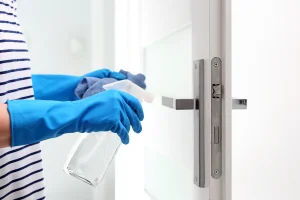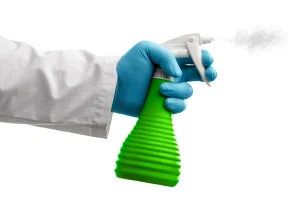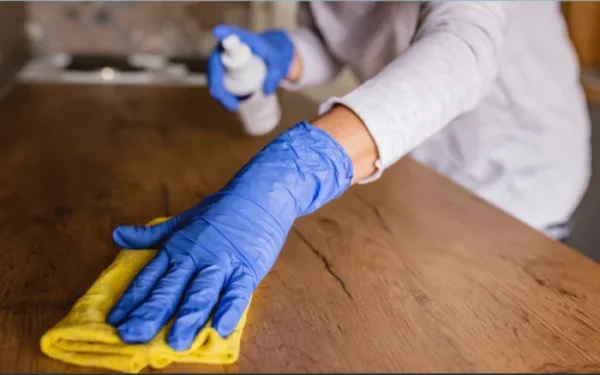Keeping your home clean is crucial for preventing the spread of diseases and maintaining a healthy living environment. But sometimes, you will also need to disinfect or sanitize your home to prevent the spread of diseases.
Did you know there is a difference between disinfecting and sanitizing? In this comprehensive guide, you will learn the best practices for cleaning, disinfecting, and sanitizing your home effectively.
From understanding when to clean, sanitize, and disinfect to learning the proper techniques, this guide will help you create a safe and germ-free living space.
So let’s dive in and find out what these terms mean.
Understand the Difference Between Cleaning, Disinfecting, and Sanitizing Your Home
Cleaning
Before you start cleaning, it’s important to understand the difference between cleaning, disinfecting, and sanitizing.
According to the CDC (Centers for Disease Control and Prevention):
Cleaning removes most germs, dirt, and impurities from surfaces.
You can accomplish this with soap and water or a cleaning solution.
Some cleaning products to clean your household with:
- Dish soap
- Detergent
- Microfiber cloths
- Miracle II Soap
Sanitizing
The next level of defense to combat more germs on surfaces is to sanitize.
According to the CDC (Centers for Disease Control and Prevention):
Sanitizing reduces germs to levels public health codes or regulations consider safe. Sanitizing uses weaker bleach solutions or sanitizing sprays.
This would mean that sanitizing is killing most of the germs: but not all of them. You should always clean the surface first before sanitizing.
Sanitizing is particularly important in areas and surfaces where food is prepared and served (like the kitchen). For food preparation, the surface should be a 99.999% reduction in microorganisms within 30 seconds. For hard surfaces not used for food service, the level should be at least 99.9% within 30 seconds.
Some common everyday household products to sanitize your home with:
- Hydrogen peroxide
- White vinegar
- Unscented bleach
- Isopropyl alcohol
You can also sanitize using high heat like a dishwasher or steam mop.
Disinfecting
You can go even further with your cleaning efforts with disinfecting.
According to the CDC (Centers for Disease Control and Prevention):
Disinfecting kills most germs on surfaces and objects. Disinfecting is done with stronger bleach solutions or chemicals.
Disinfecting is killing 99.9999% of the germs on surfaces. Again like sanitizing, you should clean the area first, then disinfect it. Disinfecting is usually done on nonporous surfaces and only on inanimate objects (nothing living).
- Hydrogen Peroxide
- Isopropanol (70% Isopropyl Alcohol)
- Disinfecting Sprays
- Bleach
It’s important to note that while cleaning may remove some germs, it may not necessarily kill them. Disinfecting and sanitizing are essential steps to ensure a germ-free environment and prevent the spread of diseases.
Disinfect or Sanitize Your Home?
Now that you have the definitions for cleaning, sanitizing, and disinfecting, which applies to your home?
Where Should You Sanitize Your Home?
You don’t have to sanitize every room and area in your house but make sure not to miss the ones below.

Clean High-Touch Surfaces Regularly
High-touch surfaces in your home, such as doorknobs, light switches, countertops, and remote controls, can hold germs and bacteria.
It’s important to clean these surfaces regularly to prevent the spread of disease. Use one of the cleaning products mentioned above and wipe to thoroughly clean these areas, paying extra attention to areas that are frequently touched by multiple people.
Make sure to follow the instructions on the cleaning product for the appropriate contact or dwell time, as this is necessary to effectively kill germs. By regularly cleaning high-touch surfaces, you can help create a safer and healthier environment for you and your family.
Kitchen (Food Preparation and Storage) and Bathroom
It would be a smart idea to sanitize some areas in the kitchen and bathroom. Both rooms can get contaminated with germs, and they are used frequently by everyone in the house.
Common germs in the bathroom and kitchen are Salmonella, Campylobacter, E. Coli, Listeria, and the Norovirus. These germs can cause symptoms ranging from diarrhea and vomiting to kidney disease and death.
In the kitchen, you should sanitize any area where you prepare food as well as where you store raw meat or any other food that can spoil in the refrigerator.
In the bathroom, you should focus on the highly used areas (shower and shower curtain, toilet, etc.) and utensils (toothbrush). To see a full list of areas that contain the most germs in your bathroom, check out this study about bathroom germs from safehome.org. If you thought the toilet had the most germs in the bathroom, you will be sadly mistaken.
Do You Have Little Ones?
If you have little ones, then you should sanitize regularly.
It would be smart to sanitize any toys your child puts in their mouth or pacifiers and the floors (hard surfaces) your child may be crawling, sitting, and lying on.
When Should You Sanitize Your Home?
When you clean your house, you don’t have to sanitize it every time but do it for the situations below.
Should You Sanitize Your Home If People Are Coming Over?
If people are coming to your home, then you would want to sanitize the high-touch surfaces, as was mentioned earlier.
Should You Sanitize Your Home If Someone in Your Home Is Sick?
If someone in the home is sick, you need to sanitize the areas the person has touched and other high-touch areas in the house, including their bedroom and bathroom.
When Should You Disinfect Your Home?
Sickness
As mentioned earlier, for sanitizing, if there is a sick person in your home, especially with a contagious illness, disinfect the high-touch areas in the house, including their bedroom and bathroom.
Bodily fluids
If there is a bodily fluid spill in your home, you should disinfect that area after cleaning it up.
Baby Changing Table
If your little one is still in diapers or potty training, disinfect their changing table or potty training equipment.
What to Consider When Disinfecting Your Home
Hospitals were the first to disinfect because of the type of environment that a hospital is. Your home is not the same as a hospital, so you won’t need to go to the same level of disinfecting.
But as stated before, there are certain situations when disinfecting is better than sanitizing your home. And there are also factors to consider and keep in mind when disinfecting that can be hazardous if not done correctly.
Use the Right Cleaning Products
When it comes to cleaning, disinfecting, and sanitizing your home, it’s important to use the right products. Not all cleaning products are effective for killing germs and bacteria, so it’s crucial to choose ones that are made for disinfecting.
Look for products labeled as disinfectants or sanitizers, as these have been tested and proven to kill germs. Additionally, make sure to follow the instructions on the product label, including any recommended dwell time. Using the right cleaning products will ensure that you are effectively eliminating germs and reducing the risk of disease transmission in your home.
Dwell time
A big reason a disinfectant will work properly is because of its dwell time (the contact time the product needs to set on the surface to kill the germs). Generally, disinfecting is going to have a longer dwell time than sanitizing.
So if you are disinfecting an area in your home, you will need to allow for the dwell time of the product, and that area cannot be disturbed by anyone (including pets) in the house. So it is recommended to disinfect when no one else is home or in that area of the home.
Harsh Chemicals
Whenever you use a household cleaning product to disinfect or sanitize your home, always follow the directions on the label. And when keeping these products in your home, always be sure to store them away in areas pets and young children cannot get them.
Another thing to consider is if you use a store-bought household cleaning disinfectant or bleach, these products contain harsh chemicals. This means you should wear gloves or other PPE (Personal Protective Equipment) when using these products. Harsh chemicals can cause breathing problems, headaches, and skin irritation if not handled correctly and worse if consumed by a child or pet.
When You Clean, Disinfect, and Sanitize Your Home, Follow Proper Cleaning Techniques

In order to effectively clean, disinfect, or sanitize your home, it’s important to follow proper cleaning techniques. Start by removing any visible dirt or debris from surfaces using a broom, vacuum, or dust cloth.
Then, apply the appropriate cleaning product to the surface and let it sit for the recommended contact time. This allows the product to effectively kill germs and bacteria.
After the contact time has elapsed, use a clean cloth or sponge to wipe away the cleaning product and any remaining dirt or residue. Finally, rinse the surface with water and dry it thoroughly. By following these proper cleaning techniques, you can ensure that your home is properly cleaned and free from harmful germs.
Establish a Cleaning Routine
Establishing a regular cleaning routine is essential for preventing the spread of disease in your home. Set aside specific days or times each week to clean, sanitize, or disinfect high-touch surfaces, such as doorknobs, light switches, countertops, and bathroom fixtures.
Additionally, clean and sanitize or disinfect frequently used items, such as phones, remote controls, and keyboards. By incorporating regular cleaning into your routine, you can maintain a clean and healthy living environment for yourself and your family.
The Conclusion to Disinfect or Sanitize Your Home
A few years back, the terms sanitize and disinfect became very popular because of the pandemic. Now that the pandemic has died down, we might not hear about them as much, but they are still essential.
Along with cleaning, we may need to go the extra step and sanitize or disinfect when necessary. And now you know the difference between sanitizing and disinfecting and when it’s appropriate to disinfect or sanitize your home.
Sanitize your home and disinfect when you need to. If you need to disinfect, be cautious when you do it so that you can keep your family and household safe.


As a retired health care worker and the grandmother of a type 1 diabetic, I am very aware of sanitizing and disinfecting. We do plenty of both around here not only because of the recent COVID-19 but because our grandson requires a relatively germ-free place to test blood sugars and adn=minister insulin injections when he is visiting. You explained the difference between the two clearly. I hope we all continue to be so vigilant in our personal and professional hygiene moving forward. It could lead to fewer colds and cases of flu as well. Take care and stay safe.
Thank you Deb and I hope we can all take our hygiene more seriously. Stay safe and healthy as well!
I have been lucky enough to come across some Lysol spray recently and disinfecting wipes. I am very uptight about my house being clean. I can deal with clutter to a certain point with 4 kids, but it has to be clean clutter. We all work together to sanitize and disinfect surfaces around the house, and I clean my kitchen very well and often. I think more people need to be aware of this though. Given how hand soap and sanitizer has flown off the shelves after all of this, it makes me wonder if people ever even washed their hands before.
I’m glad you’re able to sanitize and disinfect your home. You’re right people do need to understand that it is important to sanitize on a regular basis and disinfect when necessary. Stay clean and safe.
Hi,
this is a beautifully written article and you deserve full marks for it. I agreed with all the things you’ve mentioned in your post.
The way you have explained how can we protect our home in this situation in different ways like going in for sensitization & disinfection is indeed great. And in this COVID situation, we should be careful with our cleaning otherwise people and their whole family can suffer a lot we should not take a risk and always sanitize our home.
I think you would have a lot of people visiting your website and gaining from your experience and knowledge about the topic.
Thanks,
Aparna
Thank you Aparna, I’m glad you agreed with it. I hope it can help you stay clean and safe.
Our lives are certainly different now and will be so for a long time …
I live alone and I am not a great housewife ;-), but I realize that I have to clean more often. I have homemade spray solution made of alcohol and water which I use when I go out but also at home. I also like to use white vinegar for cleaning. I need to get more of a cleaning routine, though, I have never been good at it, it is very important now … Your article is providing me with many good tips!
That’s great to hear Christine. I’m glad you found it useful. Stay clean and safe!
I’m glad I’ve come across your post, as it seems like I am sanitizing my home and regularly. I tend to use the more of natural (well almost) ingredients of white vinegar and a few drops dish liquid soap and essential oil (optional) in a spray bottle with tap water. It works wonders and keeps my home free from harsh chemicals too. I’ve even written a post about it. Natural is always the best.
Looks like from the year 2020 we need to be more conscious about sanitizing.
Please be safe everyone.
Many Thank for sharing.
I’m glad you did too Habib. Natural, non-toxic products are the way to go when cleaning your home and sanitizing or disinfecting it.
You are spot on with this article.
Sanitizing and disinfecting reduces infections and it has become so important now especially with the outbreak of covid19.
Thank you. I hope it is useful for you.
The world has certainly changed in 2020 and one thing that is actually a good thing is that people now seem to be a lot more aware and a lot more hygienic than in the past. I have a very specific procedure now when I come back from being outside or come from the shops.
My shoes are left just inside the door as I come in. My clothes goes either on the floor or inside the washing machine as soon as I come in and I go shower immediately and wash my hair.
In regards to shopping I make use of either a bleach/water solution to spray my shopping or use antibacterial gel to wipe all products before it goes into the refrigerator. After the procedure I do wash my hands also.
I agree. People seem to be changing their hygienic and cleaning habits for the better. Thanks for sharing your routine. It sounds like it is very healthy and hygienic.